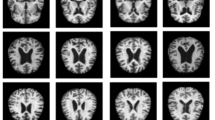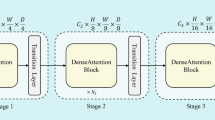Abstract
Attention-based convolutional networks have attracted great interest in recent years and achieved great success in improving representation capability of networks. However, most attention mechanisms are complicated and implemented by introducing a large number of extra parameters. In this study, we proposed a lightweight attention-based convolutional network (ConvNet-CA) that has a low computation complexity yet a high performance for brain disease detection. ConvNet-CA weights the importance of different channels in features maps and pays more attention to important channels by introducing an efficient channel attention mechanism. We evaluated ConvNet-CA on a publicly accessible benchmark dataset: Whole Brain Atlas. The brain diseases involved in this study are stroke, neoplastic disease, degenerative disease, and infectious disease. The experimental results showed that ConvNet-CA achieved highly competitive performance over state-of-the-art methods on distinguishing different types of brain diseases, with an overall multi-class classification accuracy of 94.88 ± 3.64%.
Access this chapter
Tax calculation will be finalised at checkout
Purchases are for personal use only
Similar content being viewed by others
References
Atlas, S.W.: Magnetic Resonance Imaging of the Brain and Spine, vol. 1. Lippincott Williams & Wilkins, Philadelphia (2009)
Chollet, F.: Xception: deep learning with depthwise separable convolutions. In: Proceedings of the IEEE Conference on Computer Vision and Pattern Recognition, pp. 1251–1258 (2017)
Górriz, J.M., et al.: Artificial intelligence within the interplay between natural and artificial computation: advances in data science, trends and applications. Neurocomputing 410, 237–270 (2020)
Gudigar, A., Raghavendra, U., Ciaccio, E.J., Arunkumar, N., Abdulhay, E., Acharya, U.R.: Automated categorization of multi-class brain abnormalities using decomposition techniques with MRI images: a comparative study. IEEE Access 7, 28498–28509 (2019)
He, K., Zhang, X., Ren, S., Sun, J.: Deep residual learning for image recognition. In: Proceedings of the IEEE Conference on Computer Vision and Pattern Recognition, pp. 770–778 (2016)
Hu, J., Shen, L., Sun, G.: Squeeze-and-excitation networks. In: Proceedings of the IEEE Conference on Computer Vision and Pattern Recognition, pp. 7132–7141 (2018)
Huang, G., Liu, Z., Van Der Maaten, L., Weinberger, K.Q.: Densely connected convolutional networks. In: Proceedings of the IEEE Conference on Computer Vision and Pattern Recognition, pp. 4700–4708 (2017)
Johnson, K.A., et al.: The whole brain atlas (2001)
Nayak, D.R., Dash, R., Majhi, B.: Discrete ripplet-II transform and modified PSO based improved evolutionary extreme learning machine for pathological brain detection. Neurocomputing 282, 232–247 (2018)
Srivastava, N., Hinton, G., Krizhevsky, A., Sutskever, I., Salakhutdinov, R.: Dropout: a simple way to prevent neural networks from overfitting. J. Mach. Learn. Res. 15(1), 1929–1958 (2014)
Szegedy, C., Vanhoucke, V., Ioffe, S., Shlens, J., Wojna, Z.: Rethinking the inception architecture for computer vision. In: Proceedings of the IEEE Conference on Computer Vision and Pattern Recognition, pp. 2818–2826 (2016)
Tofts, P.: Quantitative MRI of the Brain: Measuring Changes Caused by Disease. Wiley, USA (2005)
Wang, J., Zhu, H., Wang, S.H., Zhang, Y.D.: A review of deep learning on medical image analysis. Mob. Netw. Appl. 26(1), 351–380 (2021)
Wang, Q., Wu, B., Zhu, P., Li, P., Zuo, W., Hu, Q.: ECA-net: efficient channel attention for deep convolutional neural networks. In: 2020 IEEE CVF Conference on Computer Vision and Pattern Recognition (CVPR). IEEE (2020)
Wang, S., Du, S., Atangana, A., Liu, A., Lu, Z.: Application of stationary wavelet entropy in pathological brain detection. Multimed. Tools Appl. 77(3), 3701–3714 (2016). https://doi.org/10.1007/s11042-016-3401-7
Acknowledgements
This paper is partially supported by Medical Research Council Confidence in Concept Award, UK (MC_PC_17171), Royal Society International Exchanges Cost Share Award, UK (RP202G0230), British Heart Foundation Accelerator Award, UK (AA/18/3/34220), Global Challenges Research Fund (GCRF), UK (P202PF11), Sino-UK Industrial Fund, UK (RP202G0289), and Hope Foundation for Cancer Research, UK (RM60G0680).
Author information
Authors and Affiliations
Corresponding authors
Editor information
Editors and Affiliations
Rights and permissions
Copyright information
© 2022 Springer Nature Switzerland AG
About this paper
Cite this paper
Zhu, H., Wang, J., Wang, SH., Zhang, YD., Górriz, J.M. (2022). ConvNet-CA: A Lightweight Attention-Based CNN for Brain Disease Detection. In: Ferrández Vicente, J.M., Álvarez-Sánchez, J.R., de la Paz López, F., Adeli, H. (eds) Artificial Intelligence in Neuroscience: Affective Analysis and Health Applications. IWINAC 2022. Lecture Notes in Computer Science, vol 13258. Springer, Cham. https://doi.org/10.1007/978-3-031-06242-1_1
Download citation
DOI: https://doi.org/10.1007/978-3-031-06242-1_1
Published:
Publisher Name: Springer, Cham
Print ISBN: 978-3-031-06241-4
Online ISBN: 978-3-031-06242-1
eBook Packages: Computer ScienceComputer Science (R0)




